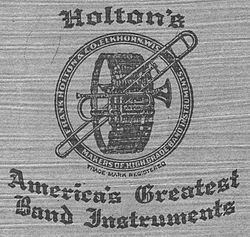Area served Worldwide Website www.conn-selmer.com Founded 1898 | Founder Frank E. Holton Headquarters Elkhart Number of locations 1 | |
 | ||
Parent organization | ||
Holton is a brand owned by Steinway Musical Instruments' Conn-Selmer division. Founded by Frank Holton, a trombone player in 1898 in Chicago, Illinois, the firm built brass instruments in Elkhorn, Wisconsin from 1918 until 2008 before moving all current production to Elkhart, Indiana and Eastlake, Ohio.
Contents
Frank Holton
Frank E. Holton was born March 10, 1858 in Allegan, Michigan to farmers Otis (b. 1827) and Hanna A. (b. 1829) Holton. He grew up with three sisters: Emma E. Holton, Alice Holton and Leona Holton. By the time he was 34, Frank Holton was an accomplished trombone player and principal trombone of the Sousa Band, a role that would later be filled by Arthur Pryor. In 1885 he had partnered with James Warren York in York & Holton, York's successor to the instrument maker Smith & York which became J.W. York and Sons before Holton established his own company in 1898.
Frank Holton's wife Florence was a music teacher. They had no children. Frank Holton, though not an instrument maker himself, expanded his company to manufacture instruments which was his occupation until retiring at age 80. Frank Holton died after a protracted illness on April 16, 1942 at the age of 84.
Chicago
Frank Holton's first business venture on his own was a small rented shop with a desk, two counters and two chairs that he had to paint himself at Clark and Madison streets in Chicago, in 1898, where he sold used instruments and his own formula slide oil for trombone. Unable to make the rent at times, Holton was known to pawn instruments at a shop on Clark Street between 1898 and 1900.
By 1907, a skilled horn maker had been hired, and the production of Holton instruments required the construction of a factory on the West Side of Chicago. It would be home to Frank Holton & Company for only a decade.
Elkhorn
In April 1918, Holton opened a factory in Elkhorn, Wisconsin moving over 200 employees and 85 carloads of machinery from Chicago. The city had lured Holton to Elkhorn through the efforts of a group of local businessmen, who, acting under city mandate, built the new factory which was turned over to Holton and Co. upon their arrival. That building remained as the core of the Holton factory until the decision in 2011 to merge Holton horn production with King and Conn instruments in Eastlake, Ohio.
While the factory had been paid for by the city of Elkhorn, the cost of training skilled labor resulted in the first profits there not being seen until 1920.
Along with machinery and employees, Holton brought the company band to Elkhorn which would quickly merge with the storied Elkhorn Band, which had been founded in 1840 by Charles Seelye only 3 years after the town of Elkhorn itself. The band had served as the 12th Regimental Band from 1861 to 1864 during the Civil War.
Already building a full line of high-end brass instruments, Holton recognized the growth of music in the schools and began selling student-line instruments built by other workshops under the trade names Pertin and Beaufort. In the early 1930s, the Holton Collegiate line of student horns built at the Holton factory was introduced. The defunct Collegiate line was re-introduced in 2005 by the modern Holton Company again targeting a balance of quality and price suitable for school music programs.
In addition to building the company in Elkhorn, Frank Holton also built a subdivision of 5 and 6 room bungalows in 1919. The 25 homes were priced in the $3,000 to $4,000 range.
Post Frank Holton
After retiring, at age 82 Frank Holton sold the company to employee William Kull. The company was run from that point forward by sales manager Elliot Kehl, though Kull would retain the title CEO until he died in 1944.
During World War II, the company performed defense work, as did most all instrument manufacturers. Following the war, Elliot Kehl secured a controlling interest in the company and began development of several new products including the Farkas Model French horn and a new line of saxophones.
Modern subsidiary
In 1964, the woodwind manufacturer Leblanc purchased the Holton company to form a band instrument company with a full line of instruments. Later, after being taken over by Conn-Selmer, the original factory in Wisconsin was closed down but the brand still offers both student and professional instrument, built in the Vincent Bach factory. Some of the headline products built during the post-acquisition period include:
Holton currently produces cornets, trumpets, french horns and trombones as well as Holton oil.
Holton artists
The Holton company relied on endorsement by leading artists as one of its primary marketing tools. Often these artists collaborated on the design of instruments that they would then play and promote. Some would subsequently leave Holton to build instruments themselves.
Among these were :
Not all ventures with artists were successful. The Holton Falcone Model baritone horn, developed at the end of the 1970s with input from the namesake of the Leonard Falcone International Tuba and Euphonium Festival was dropped after only a short run when Leonard Falcone refused to endorse or play on the production version.
